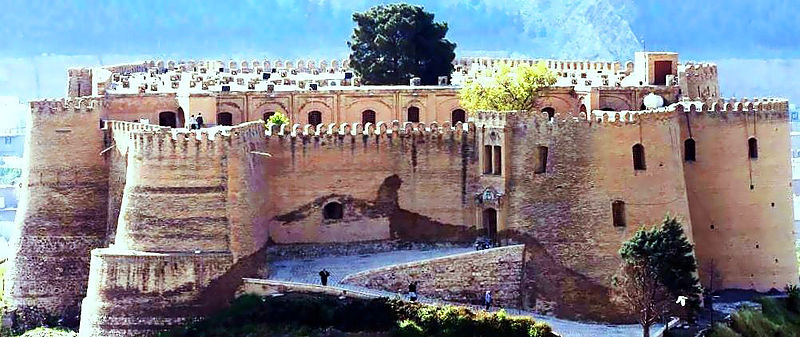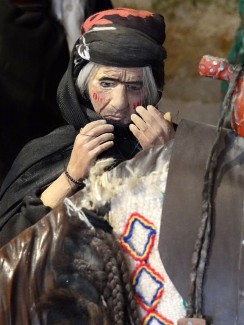Our Article about the Ruling Woman Devlet Hatun of Iran on MintPress
Great Women In Islamic History:
Devlet Hatun Of Iran
Follow @promosaik_ @promosaik_

Castle in Hurremabad, seat of government in Lesser Luristan
(part of
modern-day Iran) in the days of Devlet Hatun. (Wikimedia / Adowus)
Other selections from this series: Introduction: A Forgotten Study Of Female Political Power In Muslim History, Türkan Hatun of Iran, Padishah Hatun of Iran and Ebesh Hatun Of Iran.
Devlet Hatun of the Hurshitoğulları State in Lesser Luristan
Between the sixth and ninth centuries of the Hegira, two states were
founded in the southwest region of Iran which was occupied by the Lur
tribes. Of these one was the “Great Lurlu,” also known as “Hezarespî” or
“Fazlûye.” The other was the kingdom of “Lesser Luristan” or “Beni
Hurshit” (translation: the sons of Hurshit).
Since Bahriye Üçok’s work is concerned only with the latter, only
Lesser Luristan will be discussed in this chapter about Devlet Hatun.
A brief history of Lesser Luristan
The rulers of the state of Lesser Luristan were descended from the
Jangruî tribe. It was originally called “Hurshitoqullari” and continued
to be known by this name until the sixteenth century, after Muhammed
Hurshid who was a former vizier of the Lurlus and who was the first
ruler from this family. The name of Lesser Luristan, which was the area
where it was situated, was not given to the Hurshitoqullan state until
after the sixteenth century.
The founding of this state, the capital of which was Hurremabad,
occurred roughly speaking in about 591/1195. Unfortunately, the order
and dates of succession of the rulers who held power in this country for
about 400 years are not accurately known.
İzzüddîn Kürshasb, who was the fourth ruler, was followed by Halil;
when Halil died in 1242
Mes’ud, who succeeded him, was not accepted as
sovereign by the Caliphate at Baghdad. Accordingly, Mes’ud appealed to
the Mongol, who put an army at his command. In this way, he joined in
the Baghdad campaign (1258) and obtained a large share of loot.
In 1260, Mes’ud died and a fierce struggle for succession took place
between his sons Jelâlüddîn and Nâsırüddîn. The Mongols made this a
pretext for interference and Abaka put an end to the dispute by choosing
their uncle Halil’s son Tajüddîn Shah as sultan.
Tajüddîn ruled for seventeen years, after which the sixth ruler
Mes’ud’s other two sons, Feleküddîn Hasan and İzzüddîn Hüseyin (1268)
commenced to share sovereignty in Lesser Luristan. At first these two
brothers managed the areas which had been allotted to them extremely
well, but later İzzüddîn Hüseyin began to behave with cruelty, upon
which in 1292 Keyhatu removed them both and replaced them on the throne
with Jemalüddîn Hızır. But for this he was obliged to call upon the
Mongol army for help.
Later İzzüddîn Hüseyin’s son İzzüddîn Muhammed, famed for his good
looks, came to the throne at an early age. However his cousin Bedrüddîn
Mes’ud emerged as a rival and tried to obstruct him; indeed Bedrüddîn
obtained permission from Sultan Oljaytu to take possession of the Dilâr
region, but a short while later Izzüddîn Muhammed’s tax rights over all
these parts were recognized.
Owing to his services and his obedience to the Mongols, İzzüddîn
Muhammed continued to rule Lesser Luristan throughout his lifetime, in
so-called independence, and he died in 716/1316-7. In spite of the lack
of sources which give information on this subject, it appears that on
İzzüddîn Muhammed’s death he left neither a son nor yet a brother to
succeed him.
Since neither the Mongols nor the Turks, nor nations related to them
had any rules on the question of succession to the throne, it was
thought appropriate that the dead king should be succeeded by his wife
Devlet Hatun (716/1316-7), who was the daughter of Shemsüddîn, also of
this family.
Devlet on the throne

of a Lurish woman in mourning from the Ethnographic Museum inside
Falak-ol-Aflak Castle. The woman wears a black headscarf and robe, has
red makeup on her face. (Wikimedia / Adam Jones)
Devlet Hatun, who came to the throne as the 14th of the
Hurshitoqullari rulers, was unable to retain power for long. She was
not, in any case, the ruler of a completely independent state, but was
chief of a semi-independent country that owed allegiance to the powerful
Ilhan Empire.
This being the case, she could not prevent the Mongols from
interfering in the affairs of the state. The people were heartily tired
of the Mongols, but Devlet Hatun was not a strong or capable woman like
the ruler of Kirman, Türkân Hatun, or the Turkish Empress in Delhi, Raziyye Sultan. In addition, she was inclined to keep herself withdrawn and closely veiled, which made her unable to conduct affairs.
In the same year, Ebu Said Bahadır Khan came to the Ilhan throne.
Devlet Hatun, fearing that Lesser Luristan — which was extremely rich in
various types of metal — would altogether lose its independence under
Mongol pressure, obtained the approval of the Mongol council to
relinquish her rule in favour of her own brother İzzüddîn Hüseyin.
Thus, with his succession in this year the throne in Hurremabad
passed to another branch of the Hurshitoqullan. During the fourteen year
reign of İzzüddîn Hüseyin II the people experienced a time of peace and
prosperity. His son Shüjaüddîn Mahmud II, who succeeded him, was
murdered by his own men. He was succeeded in turn by his son Melik
İzzüddîn Hüseyin III, who came to the throne at the age of twelve. The
various interesting adventures during his lifetime are related at length
in “Zafernâme” (Book Of Victories).
As regards Devlet Hatun, according to the anonymous writer of
“Tarih-i İskender,” after abdicating from the throne, she married the
Greater Lurlu’s Yusuf Shah. It is impossible to obtain further
information concerning Devlet Hatun from Hamdullah Kazvinî who wrote
“Tarih-i Güzide” at the same time that all these events were taking place.
For this reason, her general attitude to events inside and outside
the country, and the story of what befell her remain obscure. However,
by relinquishing to her brother, after a brief period of rule, the
throne she had inherited from her husband, she ensured the continuation
of this little state. By preventing it from passing entirely under
foreign domination, she gained for herself an important place in its
history.
The author writes: “In the above short account it has been possible
to give a fresh example of how, even in Luristan, which was the nearest
to Arab countries in the Islamic world, the rights of sovereignty were
not withheld.” This is an important passage to show the negative
prejudice by Bahriye Üçok concerning female power in the Arabic world
because of her Kemalist world-view.
After Emîr Îzzüddîn Hüseyin III, who was a descendant of Devlet
Hatun’s, eight more rulers, the names of whom are written in the
dynastic table, succeeded one another to the throne of the
Hurshitoqullan, until finally, in 1596, the Safevîs completely conquered
Lesser Luristan, thus finally bringing its political life as a
semi-independent state to an end.


